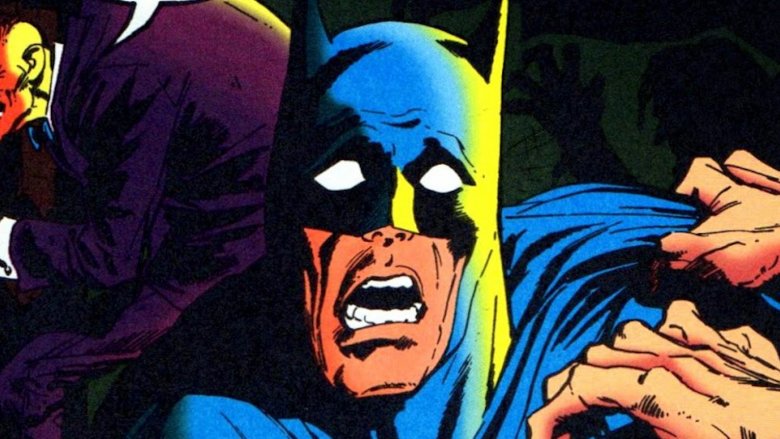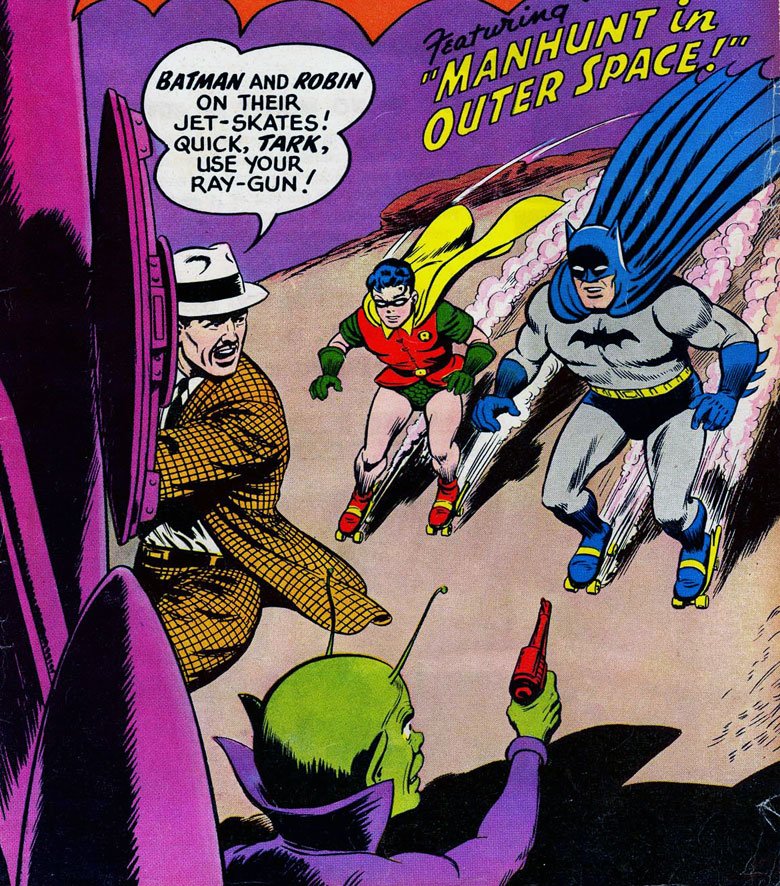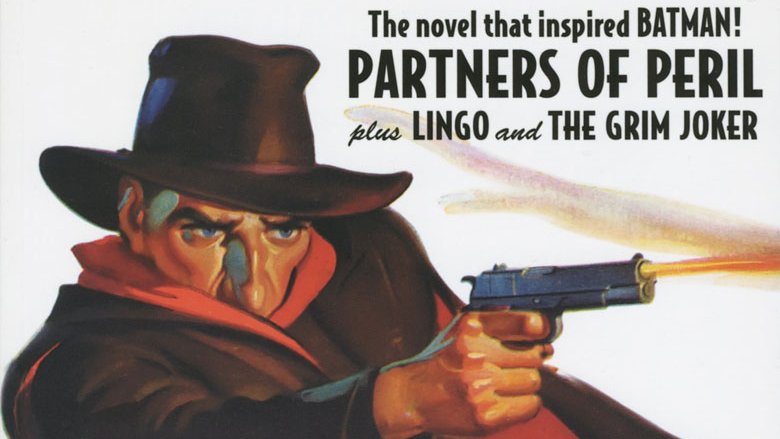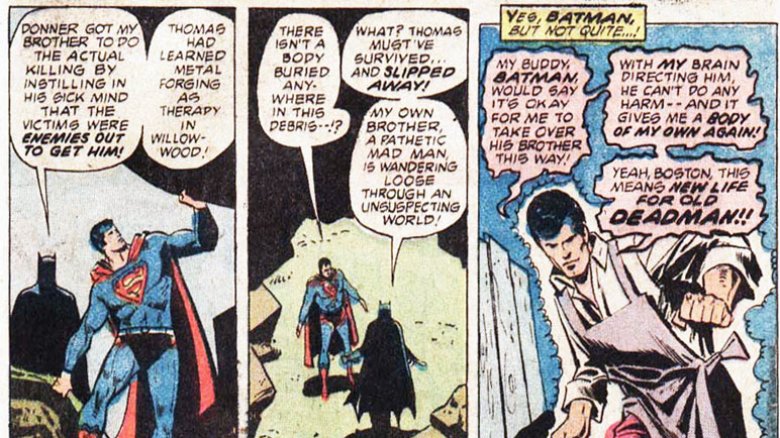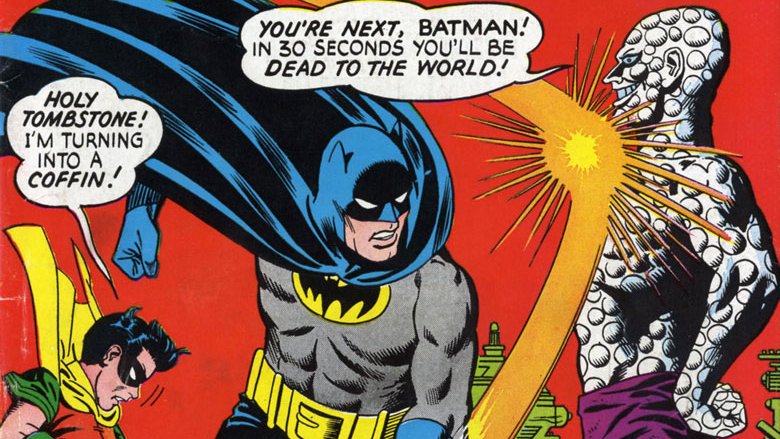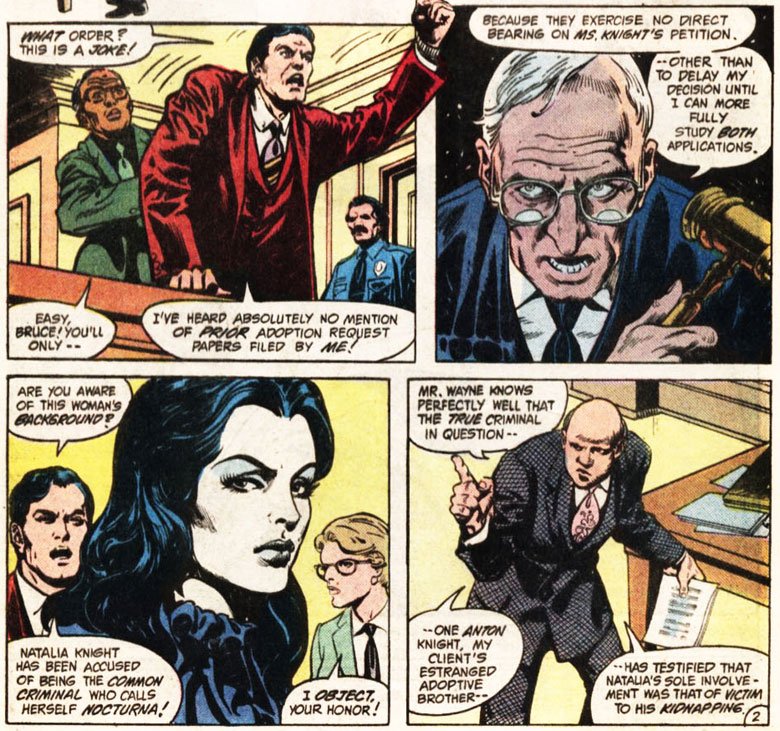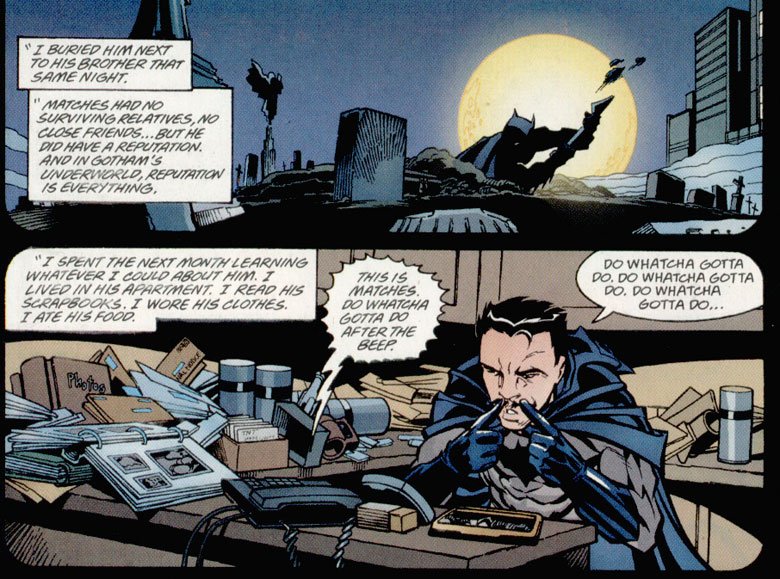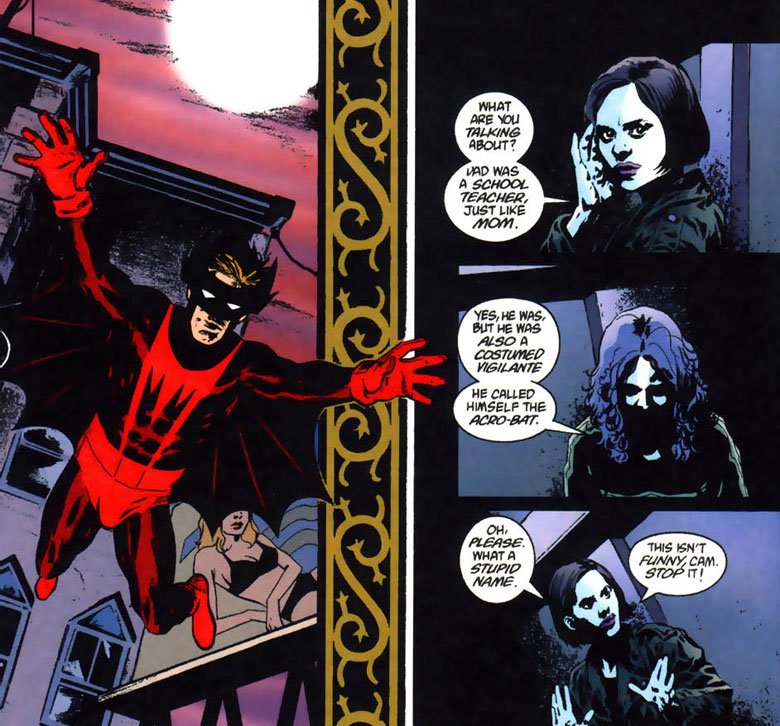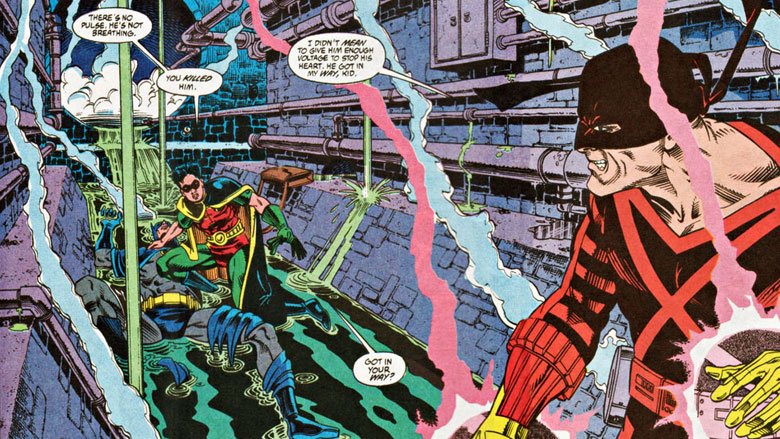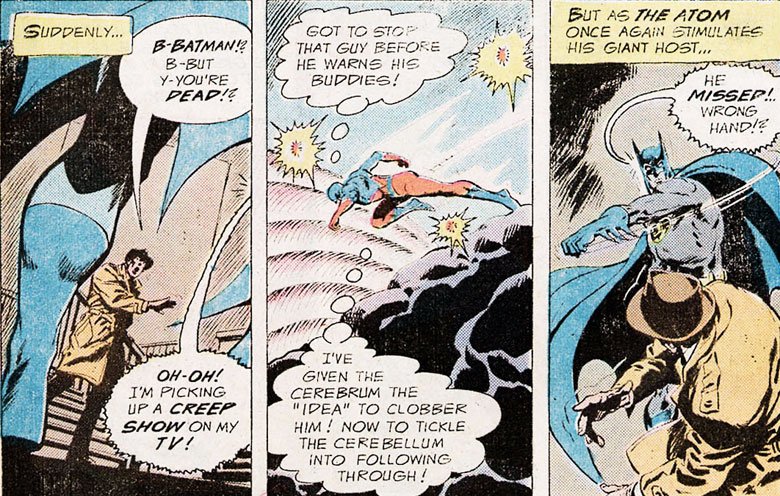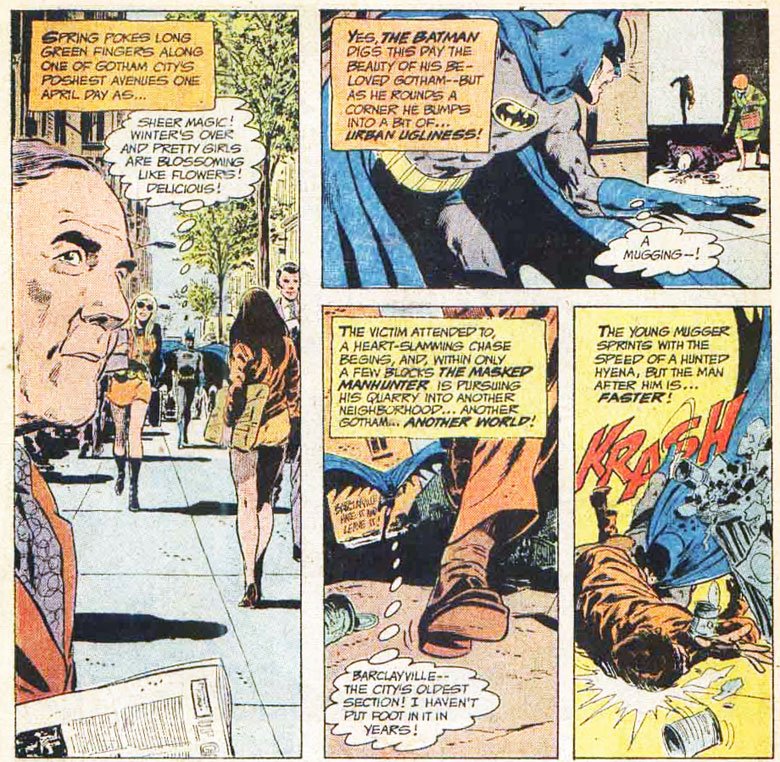What DC Wants You To Forget About Batman
When you think about Batman, your mind probably goes to the grim, ultra-competent avenger who stalks Gotham City by night meting out a darker brand of justice to the criminals that would destroy it, and you're not wrong. That's certainly the image that's had a lot of success in pop culture, making Batman not just one of the most popular superheroes to ever hit the comics page, but propelling him to success in TV and movies as well. But here's the thing: since his debut in 1939, there have been thousands of stories about Batman, and, well, they can't all be winners.
So from weird adventures to strange habits to those few times that he got the wrong end of a fight, there are more than a handful of things about Batman that DC would probably be happy for readers to forget—and we've found ten of the biggest offenders.
He used to go to outer space all the time
There are very few stretches of comics that remain as unloved and ignored as the sci-fi Batman stories of the 1950s. Really, though, it's not their fault that they were so weird. The very first Batman stories saw the Dark Knight dealing brutal—and often deadly—justice to mobsters, vampires, and sinister mad scientists, and while the tone certainly shifted pretty dramatically as early as 1940 with the arrival of Robin, his enemies were still those same sort of crooks. When the Comics Code arrived in the early '50s, however, its primary target was EC's line of wildly successful crime comics, and in an effort to cripple the competition, the publishers behind the code expressly forbid the exact sort of violence, murder, and police corruption that Batman, still a wildly popular character, was designed to fight against.
So how do you tell stories about a crimefighter when he doesn't have any crime to fight? The answer, at least according to folks like editor Whitney Ellsworth, was to just make Batman more like DC's other most popular character, Superman. Thus, Gotham City's spooky crime-fighter and his sidekick were transplanted into stories about alien bank-robbers and far-off worlds. And it wasn't exactly a great fit.
As fun as those stories can be, they don't really feel like Batman, and by the '70s, they were pretty roundly ignored as the fever dreams that they felt like. Even in Grant Morrison's run, which drew inspiration from some of the weirdest '50s stories and approached Batman with an "everything happened" approach to continuity, those alien worlds were recontextualized as hallucinations and fever dreams—and when your story's too weird for the guy who had Batman zapped with laser beams that sent him back to caveman times, that's saying something.
He was pretty heavily "inspired" by the Shadow
One of the reasons that's often given for Batman's success is how unique he was in the Golden Age. Superman's sudden and overwhelming success prompted a massive crowd of imitators, each more colorful and powerful than the last, but Batman was different. The darker costume, the more menacing demeanor, even the fact that he didn't have super-powers helped him to stand out in the crowd of characters clamoring to be the next Superman. But "unique" isn't really the right word, since Bill Finger and Bob Kane were pretty much just ripping off the Shadow.
The first Batman story, "The Case of the Chemical Syndicate," appeared in Detective Comics #27 in 1939, but three years earlier, the Shadow—a pulp hero known for his dark, menacing demeanor and violent, guns-blazing adventures—starred in a novel called Partners of Peril. To say that Batman's debut adventure "borrowed" from that story is the understatement of the century. It's a beat-for-beat adaptation with a slouch hat swapped out for pointy bat ears, right on down to Batman's early penchant for guns and his identity being revealed as millionaire socialite Lamont Cranston—er, Bruce Wayne.
The good news is that within a few months, Batman co-creator Bill Finger and artists like Jerry Robinson, Sheldon Moldoff, and, to a much lesser extent, Bob Kane, were writing stories that distanced the Caped Crusader from his inspiration, starting with the origin story in Detective #33. And hey, at least he's not alone. Just ask Superman if he knows anything about Clark "Doc" Savage and his arctic Fortress of Solitude.
His older brother was a murderer who was possessed by a ghost
Back in 2012, Scott Snyder and Greg Capullo capped off their "Court of Owls" storyline by revealing that the villainous Lincoln March may have actually been Thomas Wayne Jr., Batman's older brother. The thing is, Thomas Jr. wasn't exactly a new character, and as weird as it might've been for him to serve as an immortal assassin for a secret owl-themed cabal that ruled over Gotham City from the shadows, it's got nothing on the story where he made his first appearance.
It happened in World's Finest #223's "Wipe The Blood Off My Name" in 1974, when Bob Haney and Dick Dillin told a story so weird that even Batman himself referred to it as "the most stunning, shocking thing that ever happened in my whole life...which has not exactly been dull." In a team-up with Superman and the ghostly Deadman, Batman followed the trail of a murderer who killed his victims with gigantic razor-sharp boomerangs to Willowood Sanitarium, and discovered that the man he was hunting was the brother he never knew. It seems Thomas had been driven insane by a car accident when he was a baby (because sure, why not), and after learning the craft of boomerang-making as part of his therapy, he escaped as an adult and was manipulated to send him on a very complicated murder spree. And that's not the weird part.
No, that happens at the end of the story, when Deadman, a ghostly superhero with the ability to possess the living, just decides to take over Thomas' body as his new corporeal home—without ever telling Batman. Instead, he just assumes that his "buddy, Batman, would say it's okay for me to take over his brother," and wanders off to have his own adventures. Even for the closest buddies, that's a pretty big leap to make, and needless to say, no other creators ever referenced this story (or this version of Thomas Jr.) ever again.
His butler was once killed and resurrected as a crime boss called the Outsider
Speaking of weird things that have happened to the Batman family, Alfred's brief tenure as a telekinetic crime boss who looked like a humanoid golf ball is also something that we don't really talk about anymore.
In 1964's Detective Comics #328, Jack Schiff and Sheldon Moldoff seemingly killed off Alfred, having him sacrifice his life to save Batman and Robin from being murdered by crooks who were on the verge of discovering their secret identities. Six months later, though, Batman was faced with a new foe: The Outsider. For almost two years, the Outsider challenged the Dynamic Duo, acting as a mastermind who manipulated other villains into acting on his behalf. When they finally confronted him, though, it was revealed that the Outsider was actually Alfred, who had been resurrected by a scientist whose "regeneration machine" mutated him and drove him to hate his former employers. Fortunately, the process turned out to be extremely easy to reverse, and before long, he was back to dusting the Batcave.
Unlike Thomas Jr., this one actually was mentioned again later. In DC Comics Presents #83, Mike W. Barr and Irv Novick pit Batman and his new team, the Outsiders, against their namesake. It turns out that even 20 years after they were reversed, a sharp blow to the head can still trigger a regeneration machine's effects. Who knew?
He once lost custody of Robin in a court case against a vampire
If you think that the only times Batman was weird were in the long-ago days of the Silver Age and were suddenly washed away in the '80s, well, let's talk about Nocturna for a moment.
Created by long-time Batman writer Doug Moench and legendary artist Gene Colan in 1983, Natalia Knight was about as close as you could get to a vampire without actually having someone get bitten on the neck. While working as an astronomer, she was zapped by a weird science ray that drained her skin of pigmentation and left her super-sensitive to light, and—this being superhero comics—immediately decided that her best course of action was to call herself Nocturna and join her adopted brother Anton (variously known as the Thief of Night and the Night-Slayer) in a life of crime.
She also formed one point of a weird little love quadrangle with Vicki Vale and Alfred's daughter, Julia Pennyworth, who were all vying for Bruce Wayne's affections at the time. The thing is, rather than long walks on the beach or candlelight dinners, Nocturna's strategy involved waiting for Bruce to adopt a new ward—the second Robin, Jason Todd—and then adopting him first so that Bruce would have to marry her if he really wanted to be a dad. That is bonkers, but the weirdest thing might be that it almost worked. Jason actually said in court that he'd prefer to be adopted by Natalia, only to reveal later that it had all been part of an ill-fated attempt at going undercover. Eventually, Nocturna was seemingly killed in a hot air balloon crash—no, really—and while she's made a couple of appearances since, that was the end of her attempt at the world's most complicated marriage proposal.
He once covered up a criminal's death so that he could use it to go undercover
It's fair to say that Batman's defining characteristic is his relentless pursuit of justice. No matter where crime might strike, he's always going to be there to bring it to light. Unless he can use it for his own benefit, that is.
That's what happened with Matches Malone, at least. In most depictions of Batman, "Matches" is just a disguise that Bruce Wayne wears, a false identity that he created for those occasions when he needs to go undercover with Gotham's seedy underworld. When he first appeared in Denny O'Neil, Irv Novick, and Dick Giordano's Batman #242, though, he was an actual person—a minor mob boss who got killed by his own bullet with a ricochet, and who just happened to look exactly like Bruce Wayne with a mustache. It turns out that was so handy that Batman would continue using this identity long after this this particular detail was forgotten.
In 2001, however, Brian K. Vaughan and Scott McDaniel re-told the secret origin of Matches Malone. This time around, he was an arsonist who seemingly committed suicide after the death of his brother, and after Batman discovered his badly burned body, he realized that he was the only person who knew that Malone was dead. With that, Batman covered up the death, secretly burying Matches and taking his identity for his own—only to discover years later that the real Matches Malone had faked his death. It worked out okay enough, with the real Matches winding up murdered by crooks who thought he sold them out to Batman, but it's probably for the best if we just go on assuming he's a product of Batman's acting skills rather than a sinister cover-up.
He's not the first bat-themed vigilante in Gotham City
Given how popular Batman is, it's no surprise that Gotham City would become a pretty important place in the DC Universe. Sure enough, the last 75 years have seen a history develop for the Dark Knight's hometown that's also seen it serve as the home base for other superheroes from throughout the timeline of the universe. When the DCU was restructured after Crisis On Infinite Earths, for instance, it was revealed that the Golden Age Green Lantern lived there, and Batman: Year Two featured a violent vigilante called the Reaper who was around in the years before Bruce Wayne's parents were killed. Even Jonah Hex was hanging around there back in the late 1800s.
Of course, it's one thing if Batman's not the first superhero to make his home in Gotham City. Putting him in the context of a whole universe of heroism is, at the very least, pretty interesting. If he's not the first superhero to dress up as a bat, however...that's a little weird.
In 1998, Dan Curtis Johnson and J.H. Williams III told a pretty unexpected tale in the pages of Chase, a short lived (but awesome) title about a government agent tasked with dealing with a world of super-heroes. It turned out that Cameron Chase's distrust of masked avengers came from the fact that her father was one: the Acro-Bat, who fought crime alongside an obscure, short-lived and hilariously named team called the Justice Experience. Unsurprisingly, his story doesn't end well, but once you know he was out there, it's hard to not think that Bruce Wayne was biting his style.
He was once killed by a guy called the Electrocutioner
When you think about Batman's greatest enemies, the names that usually come to mind are the big ones. The Joker. Ra's al-Ghul. Heck, you can even make a pretty decent argument for the Riddler, if you really put your mind to it. But if you're going by who actually had the most success at the goal of actually killing Batman, then the Dark Knight's greatest foe is actually one Lester Buchinsky: the Electrocutioner!
Yeah, it's hard to believe, and even harder to believe that when he (technically) killed Batman, he did it by accident. See, the Electrocutioner was another vigilante who figured that if you couldn't bring the criminals to the electric chair, you might as well bring the electric chair to them instead. In a 1992 story that ran in the pages of Detective Comics #644-646 by Chuck Dixon, Tom Lyle, and Scott Hanna, he and Batman were on the trail of the same criminal, but when the Electrocutioner zapped him with a shock big enough to stop his heart, Batman was technically dead for a good minute and a half.
The only reason that he didn't stay that way was that Robin was there, and had the good sense to wear an insulated costume that came complete with rubber boots. While the Electrocutioner originally just shrugged off literally killing the Batman, Robin eventually beat enough sense into him that he agreed to use his electric gloves as a defibrillator to shock Batman back to life. And then they both presumably agreed to never again speak of the time Batman almost died in a sewer at the hands of a D-Lister that had to be beaten into compliance by his sidekick.
He once died and became a zombie crimefighter animated by the Atom jumping around in his brain
The Electrocutioner wasn't the only one to score a (technical) kill on Batman. In Bob Haney and Jim Aparo's "The Corpse That Wouldn't Die" from
Brave and the Bold #115, however, the culprit was even less impressive than the Electrocutioner: it's a booby-trapped rain-spout rigged up by a couple of completely average criminals that did him in.
Once again, it was electricity that got him, but thanks to Batman's "iron constitution" keeping his heart beating (and Haney's delightfully nebulous understanding of how things like electricity and the human body work), he's only mostly dead. Fortunately, the Atom gets the bright idea to solve the Batman's "final" case by shrinking down and hopping around on his brain in hopes that this will stimulate his crime-fighting instincts and allow him to mindlessly do things like punch out crooks and rescue a kidnapped girl. And it works. Oh, and it turns out that having a little tiny man hop on your brain is enough stimulus to basically jumpstart everything and get you back in good working order.
Of all the stories on this list, this is the one that everyone should be talking about literally all the time. Sure, it might not be that great for the legend of the Batman to have him die at random by jumping at the wrong window, but that's really balanced out by the fact that death itself cannot stop him from getting up off a slab in the morgue and busting criminals' jaws all over Gotham City.
He actually used to smile
We don't really have any jokes for this one, it just seems like he's not having a lot fun (or walking down city streets in broad daylight) these days. C'mon, Batman! Cheer up!
